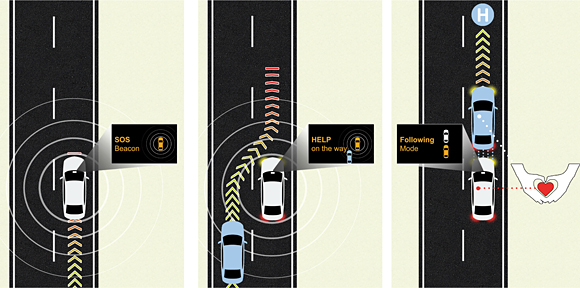Honda will showcase several of its latest developments in automated driving technology at the 2014 ITS World Congress in Detroit, September 7 through 11. Activities include a first-ever U.S. demonstration of Honda’s automated driving technology with industry-leading capabilities such as automated freeway merging, exiting and lane changing, which will be demonstrated on actual Detroit freeways, as well as a unique vehicle-to-vehicle (V2V) “virtual tow” capability for assisting a driver in distress.
Honda also will highlight other latest advancements in “V2X” technologies, including vehicle-to-pedestrian/bicycle (V2P/B) and vehicle-to-motorcycle (V2M).
“The creation and deployment of advanced, intelligent transportation systems represent the new frontier in the effort to one day eliminate traffic collisions, injuries and fatalities,” said Frank Paluch, president of Honda R&D Americas, Inc. “We will demonstrate our vision for realizing Honda’s dream of a collision-free society by showcasing our continued technological innovations in active safety, connected and automated vehicle technology.”
The pursuit of a collision-free society is part of Honda’s global safety concept of ‘Safety for Everyone’ and the company’s efforts to use technology to provide enhanced protection for automobile occupants, motorcycle riders, pedestrians and other road users. This includes numerous industry-leading initiatives in the areas of active and passive safety, pedestrian injury mitigation, motorcycle rider safety and collision compatibility.
Honda is also broadly deploying advanced driver-assist and early-stage automated driving technologies that help improve drivers’ situational awareness, such as Lane Departure Warning, Forward Collision Warning, Adaptive Cruise Control with Low-Speed Follow, Collision Mitigation Braking System™ and Road Departure Mitigation.
The company’s newest offering, the 2015 Acura TLX performance luxury sedan, utilizes the cooperative sensing of monocular camera and millimeter wave radar systems to provide for higher fidelity road sensing and collision mitigation capabilities, including pedestrian detection, steering assist and autonomous emergency braking.
Rearview cameras will be offered as standard equipment on all model year 2015 Honda and Acura vehicles (having been offered on more than 95 percent of model year 2014 vehicles).
Key Honda activities at the ITS World Congress exhibit and demonstration spaces include:
- Automated Driving on highway – an 8-mile freeway loop in the downtown Detroit area will provide attendees with an automated driving experience in a real-world traffic environment. The Honda system being demonstrated incorporates automated vehicle steering and braking and the capability for automated freeway entry, exit, lane change and other sophisticated maneuvers.
- Vehicle-to-Pedestrian/Bicycle – using dedicated short range communications (DSRC)-based communication between the vehicle and the pedestrian or bicycle rider’s compatible smart phone (with proprietary V2P/B application), Honda V2P/B technology alerts both the driver and pedestrian/bicycle rider to a potential collision, and allows the driver and pedestrian/bicycle rider to exchange courteous messages.
- Vehicle-to-Motorcycle – using communications between the vehicle and motorcycle Honda V2M technology will alert the driver and rider of a potential collision.
- V2V “Virtual Tow” – this Honda technology utilizes connected car technology to empower a driver to assist another driver in distress. The driver in need of assistance is able to alert surrounding vehicles to the need for assistance, at which point an assisting driver can virtually link up and “tow” the vehicle – with the trailing vehicle taking its driving cues from the lead vehicle via connected-car (V2V) technology and automated system – to a location where the driver can receive emergency services, such as a hospital.

- Lane-level Hazard information plus Automated Lane Change – using a combination of connected car and cloud communication technology to detect and inform the drivers of a hazard in a lane with a live image of the hazard detail. Upon receiving the detailed information the trailing vehicle can perform an automated lane change and continue smooth driving without interruption.
Source: Honda
Romain’s opinion:
The Virtual tow function looks very interesting despite the fact that it seems a bit anticipated. Indeed, it requires two V2V technology equipped cars that are in the same area. Plus, this is based on the altruism of the driver which is a non-controllable factor. Even if it could save life in some cases, I think that it won’t be wide spread in the automotive industry and remain at the proof of concept level. Which future do you foresee for this technology?





















Pingback: Honda's self-driving car, based on Accura RLX